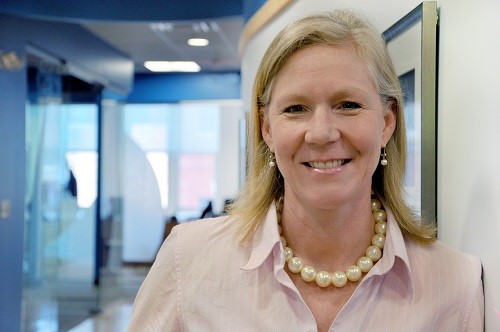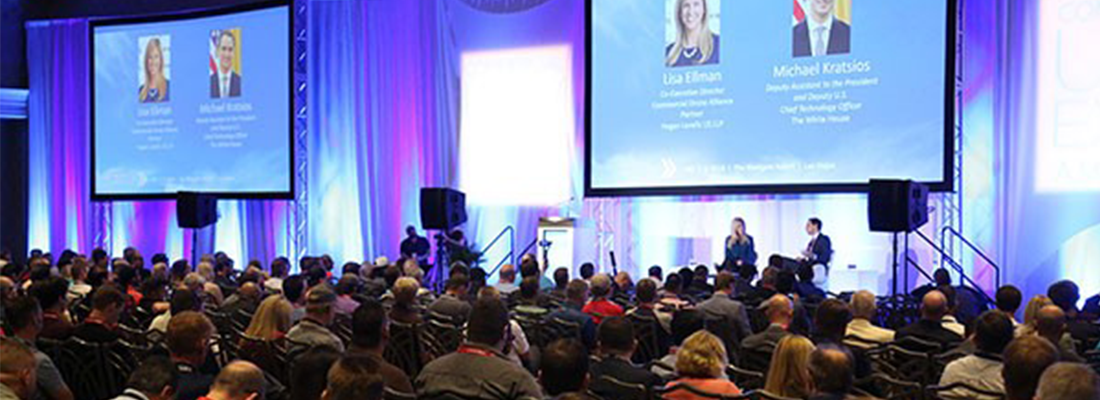Lisa Murray, Group Director at Commercial UAV Expo and partner of ADW: ‘We have more solutions on display than any other commercial drone event’

After three successful stand-alone editions of Commercial UAV Expo Europe, the organizers of Commercial UAV Expo Europe and those of Amsterdam Drone Week announced in April that they would join forces in 2020 and have both leading trade fairs and conferences take place simultaneously. That means that from 1 to 3 December 2020, RAI Amsterdam will be the most important place on earth when it comes to everything that has to do with unmanned aerial systems.
We asked Lisa Murray, Group Director at Diversified Communications, organiser of Commercial UAV Expo Europe and the American counterpart Commercial UAV Expo Americas about the reason for the collaboration and what visitors can expect. In passing, she also gave her vision of the future of the industry and explained how she attracts a high-quality audience to her exhibitions every year.
ADW: why are Amsterdam Drone Week and Commercial UAV Expo working so closely together?
Lisa Murray: “We are really excited to partner with ADW where you get the full spectrum, the whole ecosystem of drone technology. In the 2020 edition you get EASA for the regulatory aspects, you get the practical applications of what is possible right now in commercial UAS from Commercial UAV Expo Europe and then you get the future of drone technology and urban air mobility through programming and exhibits at Amsterdam Drone Week. And everything is all in one place. What it is not is a consumer or hobbyist expo. It’s really about professional use and large enterprises. People who need to know about the latest drone regulations also need to know everything about practical use. Now those people can go to one place and get everything all together.”
You also organize the Commercial UAV Expo Americas in Las Vegas every year. Is that expo different from ADW? And are you the only drone expo in the US?
Murray: “Commercial UAV Expo Americas like Commercial UAV Expo Europe, focuses on applications that are possible right now under current regulations. ADW is a little more focussed on the future of drone taxis, urban air mobility and mobility as a service and they try to bring telecom, automotive and technology together for a more futuristic infrastructure. We are focussing just on small unmanned aerial systems and what people can do with sUAS today. We’ve identified eight top industries where people are most likely using those systems. They are Construction, Energy & Utilities, Forestry & Agriculture, Infrastructure & Transportation, Mining & Aggregates, Public Safety & Emergency Services, Security and Surveying & Mapping. Many of these industries have been using remote sensing technologies for years, like terrestrial and mobile mapping and aerial lidar. Drones present a new option for data capture. Users come to us to learn how and when drones are the best application. Essentially for those industries drones are just another way to capture data."
“In the United States the market is dominated by two expos . The biggest one is AUVSI, but that one is pretty much about anything unmanned: under water, military, defence. Ours is just about the small UAV’s used for commercial purposes. We are the leading commercial event.”
What is special about Commercial UAV Expo Americas?
Murray: “We have live outdoor drone demonstrations. We take 350 people out to a test site in the desert where they can see the systems in action. We do a range of scenarios involving public safety and law enforcement . We have agricultural applications, inspection scenarios and others. Vendors will be demonstrating parachute systems, detect and avoid technology, thermal imaging, threat detection systems and more. A whole range of fixed wing and, multi rotor systems will be demonstrated. At the site stands a giant LED screen so that people can actually see the data that is coming out of the drones and what they do with those data. In fact we bring all the end users together with the manufacturers so they can ask questions and see everything in action. It is very interactive, because if you spend so much money on new technology you want to see it fly outside a cage."
“Another critical point about our expo is that we have the largest number of solutions providers on display. That means Commercial UAV Expo Americas has more solutions on display than any other commercial drone event.”
What kind of visitors do you focus on?
Murray: “Mainly end-users. I am proud to say we attract large enterprises: huge utility companies, oil and gas companies, large news organisations. All people who are really involved in drone technology in a big way.”
“What Diversified Communications is known for is that we can deliver a really qualified audience. We may not be the biggest or the most broad, but we’re quite focussed on certain industries, especially the drone industry. We can deliver really good buyers and high quality solutions. We choose our exhibitors by asking ‘who has the best solutions?’ and try to get those people on the floor. Buyers can find a range of technologies that are possible right now. They can walk away from our events and do something differently in their job next week. That’s our goal. It’s very practical.”
How do you attract those visitors?
Murray: “We’ve always focussed on getting a really high quality visitor. That’s why we don’t put vendor product pitches on our programme. Our visitors don’t want to hear a sales pitch. They want to hear from a colleague or even a competitor how they are using drones. That’s why we put our visitors in round table sessions. We hand select about a dozen top asset owners and end users and sit them on a table with a moderator in a private room where no vendors are allowed in. Visitors really like that. They can interact with other end users at a really high level. Instead of talking to a vendor they can interact with people with the same problems or solutions. We also did those round tables in our last European expo in april and visitors really appreciated it.”
Last month, the European Commission published new rules and regulations regarding the use of drones. How do you view this in the US?
Murray: “We have something similar in the US. We tend to compare it to Part 107. Before every pilot had to get a separate permit from the FAA. Part 107 made it possible for people to get certified as a Part 107 pilot. And that made it possible for more people to fly. In addition it is a national program, not a state program, similar to the EU-regulations. When they came out last month we saw the same harmonisation of standards across the EU. That will have the same effect as Part 107: it will open up the market for more people to fly more easily.”
As you mentioned yourself, ADW is more about the future of Unmanned Air Systems. What is your vision on that future?
Murray: “It is so interesting how far along the technology companies are in terms of developing drone taxis, developing sense and avoid technologies, imagining drone ports and in some ways the tech companies are ready to go. But they will also say that the system isn’t ready to handle it. As a general observer I can see they have some work to do in terms of establishing peoples comfort level, for example with drone delivery and mobility as a service. But it is closer than most of us think. Certainly a lot of our customers are very involved with creating the unmanned traffic management systems that will handle this new form of air traffic. So it will be very interesting to hear what those companies have to say at our events: how far they have progressed and who they are working with? In the end it is inevitable. It’s more a question of when and not if. The other question will be who will become the top players in this market. Most certainly it will be a global market.”








